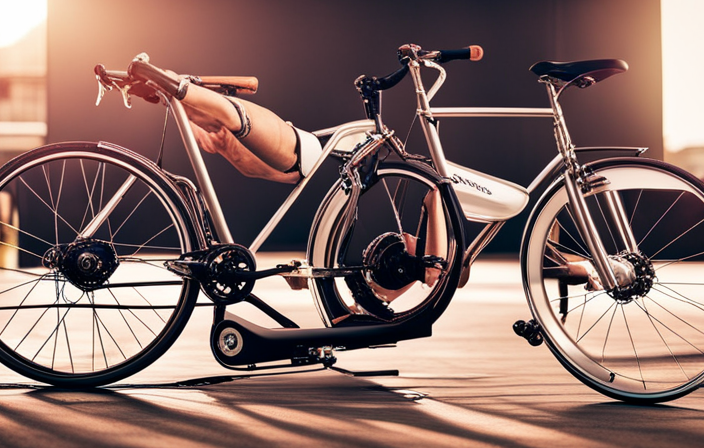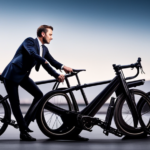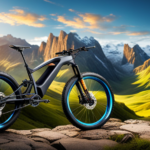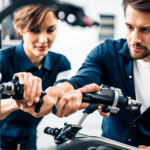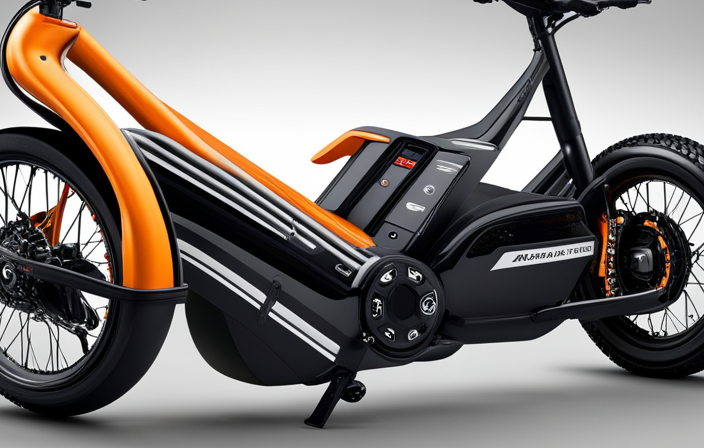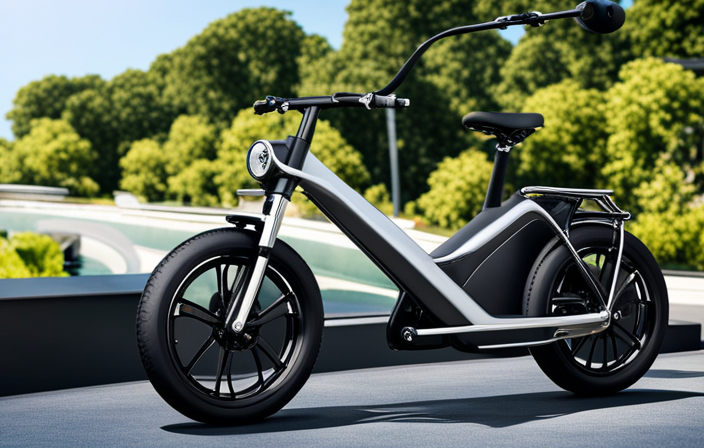Did you know that electric bike conversions have grown by over 50% in the past year?
If you’re looking to join this eco-friendly trend and convert your bike to electric, you’ve come to the right place.
In this article, I will guide you through the step-by-step process of converting your bike to electric, from assessing compatibility to installing the conversion kit.
With the right tools and knowledge, you’ll be riding your newly electrified bike in no time.
Let’s get started!
Key Takeaways
- Assessing bike compatibility and choosing the right conversion kit are crucial steps in the electric bike conversion process.
- Regular maintenance tasks, battery care, and safety precautions are important for the maintenance and troubleshooting of electric bikes.
- Upgrading brakes, gears, and components, as well as adding suspension and enhancing visibility, are possible upgrades and accessories for electric bikes.
- Spreading awareness about regulations, joining the electric bike community, and promoting the benefits of electric biking can help inspire others to adopt sustainable transportation.
Assess Your Bike’s Compatibility
Now that you’ve got your bike picked out, it’s time to see if it’s compatible with an electric conversion.
The first step in this process is to conduct a bike compatibility assessment. Start by examining the frame of your bike. Electric conversion kits typically work best with bikes that have a steel or aluminum frame, as they provide the necessary strength and stability.
Next, check if your bike has enough space to accommodate the conversion kit components, such as the battery and motor. Additionally, you’ll need to ensure that your bike’s wheels, brakes, and drivetrain are in good condition, as they may require necessary modifications for the electric conversion.
Once you’ve confirmed the compatibility of your bike, it’s time to move on to the next step and choose the right conversion kit.
Choose the Right Conversion Kit
To ensure a successful transformation, it’s crucial to select the perfect conversion kit for your two-wheeled companion. When choosing a conversion kit, there are several factors to consider to ensure bike compatibility and a smooth installation process. Here are five key points to keep in mind:
- Motor Power: Determine the appropriate motor power based on your bike’s weight and intended usage.
- Battery Capacity: Choose a battery with enough capacity to provide the desired range for your electric bike.
- Wheel Size: Ensure that the conversion kit is compatible with your bike’s wheel size.
- Brake Compatibility: Check if the conversion kit is compatible with your bike’s braking system.
- Controller Type: Select a controller that is compatible with your bike’s electrical system.
Now that you have chosen the right conversion kit, it’s time to gather the necessary tools for the installation process.
Gather the Necessary Tools
Gathering the necessary tools for the installation process is like finding the missing piece of a puzzle that brings your bike to life.
In order to successfully convert your bike to electric, it is crucial to have the right tools at hand. Firstly, you will need a set of basic hand tools such as wrenches, screwdrivers, and pliers. These tools will help you remove the existing components and install the new electric components.
Additionally, you will need specific tools for handling electrical components, such as wire strippers, electrical tape, and a multimeter for testing connections. It is also important to have a power source, such as a lithium-ion battery pack, to provide the necessary energy for your electric bike.
With these tools and power source, you are now ready to remove the existing components and start the conversion process.
Remove the Existing Components
First things first, let’s strip away those old components and give your bike a fresh start. When it comes to bike modification, repurposing old parts can save you money and time.
Start by removing the wheels, brakes, chain, and pedals. Use a wrench to loosen and remove the nuts and bolts holding these components in place. Carefully detach the chain from the gears, ensuring not to damage it in the process.
Next, remove the handlebars and the seat, as they will need to be replaced with electric-specific components. Take your time to label and organize the removed parts, as some may be reusable in the future.
With the old components removed, we can now move on to installing the conversion kit and transforming your bike into an electric powerhouse.
Install the Conversion Kit
Once the old components have been removed, it’s time to unleash the potential of your bike by installing the conversion kit, transforming it into a powerful electric machine. To begin, carefully unpack the conversion kit and familiarize yourself with its components. Consult the instruction manual for specific guidance on installation, as the process may vary depending on the kit. Generally, you will need to attach the motor to the frame, connect the controller to the battery and motor, and install the throttle and brake sensors. Ensure all connections are secure and properly aligned before proceeding.
To troubleshoot common issues during installation, refer to the troubleshooting section in the instruction manual. Common issues may include wiring problems, incorrect installation of components, or compatibility issues. Take your time and double-check each step to avoid potential problems.
With the conversion kit successfully installed, you can now move on to reassembling your bike, putting the finishing touches on your electric transformation.
Reassemble Your Bike
Now that you have successfully installed the conversion kit, it’s time to put your bike back together and experience the exhilarating ride of your newly transformed machine. Follow these steps to reassemble your bike after the bike modification:
-
Begin by reattaching the front wheel. Make sure it is securely fastened and aligned with the forks.
-
Reattach the handlebars to the stem, ensuring they are straight and tightened properly.
-
Connect the brake cables and adjust them for optimal performance.
-
Reinstall the seat and adjust it to a comfortable position.
Converting your bike into an electric one offers numerous benefits. You will enjoy increased speed and extended range, allowing you to tackle longer distances effortlessly. The added power will make uphill climbs easier, and you can also adjust the level of assistance according to your preference. Additionally, electric bikes are eco-friendly, emitting zero emissions and reducing your carbon footprint.
Now that your bike is reassembled, it’s time to move on to the next section to test and fine-tune your electric bike for optimal performance.
Test and Fine-Tune
Before taking my newly converted electric bike for a spin, I must thoroughly test and fine-tune it.
First, I will carefully check all electrical connections to ensure they are secure and functioning properly.
Next, I will adjust the motor settings, pedal-assist levels, and throttle sensitivity to suit my riding preferences.
It’s crucial to meticulously perform these tasks to guarantee a smooth and efficient electric biking experience.
Check all electrical connections and ensure proper functioning
To convert your bike to electric, you need to thoroughly inspect all electrical connections and confirm that they are functioning correctly.
Start by checking the wiring connections between the battery, controller, motor, and throttle. Look for any loose or frayed wires that may cause a poor connection or potential electrical issues.
Use a multimeter to test the voltage across each connection and ensure it matches the recommended specifications provided by the electric bike conversion kit manufacturer.
If you encounter any problems, troubleshoot them by carefully examining the affected connection, repairing any damaged wires, and securing any loose connections.
Once all electrical connections are verified and functioning properly, you can proceed to adjust the motor settings, pedal-assist levels, and throttle sensitivity. This will allow you to fine-tune the performance of your electric bike for optimal riding experience.
Adjust the motor settings, pedal-assist levels, and throttle sensitivity
Fine-tune the performance of your e-bike by adjusting the motor settings, pedal-assist levels, and throttle sensitivity for a ride that will leave you grinning from ear to ear. Here are three key aspects to consider for motor customization and performance optimization:
-
Motor settings: Access the motor controller and adjust parameters such as speed limits, acceleration rates, and torque output. This allows you to tailor the motor’s behavior to your specific riding style and preferences.
-
Pedal-assist levels: Modify the pedal-assist settings to determine how much power the motor provides when you pedal. Increase the level for a more effortless ride or decrease it for a greater workout. Experiment with different levels to find the perfect balance.
-
Throttle sensitivity: Fine-tune the responsiveness of the throttle to ensure smooth and precise control. Adjust the sensitivity to match your riding style, whether you prefer a quick burst of power or a gradual acceleration.
By customizing these motor settings, you can optimize your e-bike’s performance to suit your needs.
Now, let’s move on to the next section about safety measures and precautions.
Safety Measures and Precautions
Ensure that you prioritize safety by taking the necessary precautions when converting your bike to electric, so you can confidently enjoy your electrified rides.
Before beginning the conversion process, it’s important to perform thorough bike maintenance. This includes checking the brakes, tires, and chain to ensure they are in good working condition.
Additionally, it’s crucial to wear appropriate protective gear such as a helmet, knee and elbow pads, and reflective clothing to enhance visibility.
When working with electrical components, always follow the manufacturer’s instructions and disconnect the battery before making any adjustments. It’s also advisable to have a fire extinguisher nearby and work in a well-ventilated area to minimize any potential risks.
By adhering to these safety measures, you can convert your bike to electric with confidence, knowing that you have taken the necessary precautions to enjoy your electrified rides.
Enjoy Your Electric Bike
Now that we have covered the safety measures and precautions for converting your bike to electric, it’s time to explore the benefits and advantages of riding an electric bike.
Electric bikes offer a range of benefits, including increased speed and efficiency, reduced effort when riding uphill or against the wind, and the ability to cover longer distances without getting fatigued. Compared to traditional bikes, electric bikes provide a more enjoyable and effortless riding experience, allowing you to explore new routes and destinations with ease.
They also offer the option to switch between electric and pedal power, giving you greater control over your ride. So, whether you want to commute to work, run errands, or enjoy leisurely rides, an electric bike can greatly enhance your overall biking experience.
As we move forward, let’s consider the various upgrades and accessories that can further enhance your electric bike.
Consider Upgrades and Accessories
Enhance your electric bike riding experience by exploring various upgrades and accessories that can take your biking to the next level.
When converting your bike to electric, it’s important to consider upgrading your brakes to handle the increased speed and power. Upgrading to hydraulic disc brakes can provide better stopping power and control, ensuring your safety on the road.
Another crucial aspect to consider is choosing the right battery for your electric bike. The battery capacity and voltage will determine the range and power of your bike. Lithium-ion batteries are commonly used due to their high energy density and long lifespan.
Additionally, consider investing in accessories such as lights, fenders, and racks to improve the functionality and convenience of your electric bike.
With the right upgrades and accessories, you’ll be ready for any adventure on your electric bike.
Moving on to maintenance and troubleshooting, it’s important to regularly inspect your bike for any issues.
Maintenance and Troubleshooting
Don’t forget to give your e-bike some TLC by performing regular maintenance and troubleshooting to keep it running smoothly and prevent any potential hiccups along the way. Here are some troubleshooting tips and a suggested maintenance schedule to help you maintain your electric bike:
-
Check the tire pressure: Proper tire pressure ensures a smooth and efficient ride, so regularly check and inflate your tires to the recommended PSI.
-
Inspect the brakes: Test the brakes regularly to ensure they are working properly and adjust them if needed. Replace brake pads if they are worn out.
-
Clean and lubricate the chain: Dirt and debris can accumulate on the chain, causing it to wear out faster. Clean the chain regularly and lubricate it with a bike-specific lubricant.
To keep your e-bike in top shape, create a maintenance schedule that includes these tasks and perform them at regular intervals. This will help extend the lifespan of your electric bike.
As you move on to the next section about battery care and charging, remember that proper maintenance and troubleshooting go hand in hand with ensuring the longevity of your e-bike.
Battery Care and Charging
Regularly taking care of your e-bike’s battery and ensuring proper charging is essential for maintaining its power and longevity. Battery maintenance plays a crucial role in extending battery life and maximizing your e-bike’s performance. Here are some key tips to keep in mind:
| Battery Maintenance | Tips | Frequency |
|---|---|---|
| Charging | Use the provided charger and charge the battery after each ride. | After every ride |
| Storage | Store the battery in a cool and dry place, away from extreme temperatures. | During periods of non-use |
| Cleaning | Regularly clean the battery with a damp cloth, avoiding direct water contact. | Every few weeks |
| Inspections | Check the battery for any signs of damage or wear, such as cracks or leaks. | Monthly |
By following these battery care practices, you can extend the life of your e-bike’s battery and ensure optimal performance. Now, let’s transition into the next section where we’ll discuss the importance of staying informed about regulations regarding electric bikes.
Stay Informed about Regulations
Stay up-to-date with regulations to ensure you are aware of the rules and guidelines surrounding e-bikes. Regulatory compliance is crucial when converting your bike to electric.
Many countries and regions have specific legal requirements that must be met in order to ride an electric bike on public roads. These requirements often include maximum speed limits, power limits, and specific safety features such as lights and reflectors.
It is important to research and understand these regulations to avoid fines or legal issues. Additionally, some jurisdictions may require registration or licensing for electric bikes. Stay informed about these requirements to ensure you are in compliance with local laws.
By staying up-to-date with regulations, you can ensure that your electric bike conversion is legal and safe. This knowledge will also help you become an active member of the electric bike community and contribute to its growth and development.
Join the Electric Bike Community
Embrace the camaraderie and excitement of joining the electric bike community and connect with fellow enthusiasts who share your passion for eco-friendly transportation. Being part of this community not only allows you to meet like-minded individuals, but also provides a platform to exchange knowledge and experiences.
By engaging with other electric bike riders, you can gain valuable insights into the benefits of electric bikes and learn about the latest advancements in this eco-friendly mode of transportation. From reducing carbon emissions to promoting a healthier lifestyle, electric bikes offer numerous advantages for both the environment and riders.
By joining the electric bike community, you can stay informed about the latest electric bike benefits and contribute to the growing movement towards eco-friendly transportation. As you become more knowledgeable and passionate about electric bikes, you can spread the word and inspire others to adopt this sustainable mode of transportation.
Spread the Word
Now that I have joined the electric bike community, it’s time to spread the word and share the benefits of electric biking.
As an electric bike enthusiast, I am excited to share my experiences and knowledge with others. By spreading the word about electric biking, we can encourage more people to convert their bikes and experience the countless benefits.
Electric biking offers numerous advantages, including a greener and more sustainable mode of transportation, improved health and fitness, and cost savings on fuel and maintenance. By promoting electric biking, we can contribute to reducing carbon emissions and creating a cleaner environment.
Additionally, electric biking is an excellent way to stay active and fit, as it provides assistance when needed while still requiring physical effort. Lastly, converting to electric biking can lead to significant savings on fuel and maintenance costs, making it a practical choice for daily commuting.
Let’s spread the word about the benefits of electric biking and inspire others to join this eco-friendly and enjoyable mode of transportation.
Frequently Asked Questions
Can I convert any type of bike to electric?
Yes, any type of bike can be converted to electric. The benefits of converting include increased speed and range, reduced effort while pedaling, and eco-friendly transportation. Common challenges include finding compatible components and ensuring proper installation for optimal performance.
How much will it cost to convert my bike to electric?
Converting a bike to electric can cost around $500 to $1500, depending on the quality of components and desired features. The process involves installing a motor, battery, and controller, offering benefits like increased speed, longer range, and reduced effort while riding.
Do I need any special skills or knowledge to perform the conversion?
No special skills or knowledge are required to convert a bike to electric. However, basic mechanical skills and some knowledge of electrical systems are necessary to ensure a successful conversion.
How long does it take to install the conversion kit?
The installation time for a conversion kit varies depending on the individual and their level of experience. Common challenges include aligning the motor and mounting the battery securely.
Can I still pedal my electric bike if the battery dies?
Yes, you can still pedal an electric bike if the battery dies. Electric bikes with pedal assist and throttle offer dual mode options, allowing you to switch to pedal power when the battery runs out. This provides flexibility and ensures you can continue riding.
Conclusion
After successfully converting my bike to electric, I’ve unlocked a whole new world of possibilities. The process may seem daunting, but with the right conversion kit and tools, it becomes a manageable task.
Taking care of the battery and staying informed about regulations are crucial steps to ensure a smooth ride.
Joining the electric bike community allows us to connect with like-minded individuals, share experiences, and learn from each other.
Together, let’s spread the word about the benefits of electric biking and inspire others to make the switch.
Happy riding!
